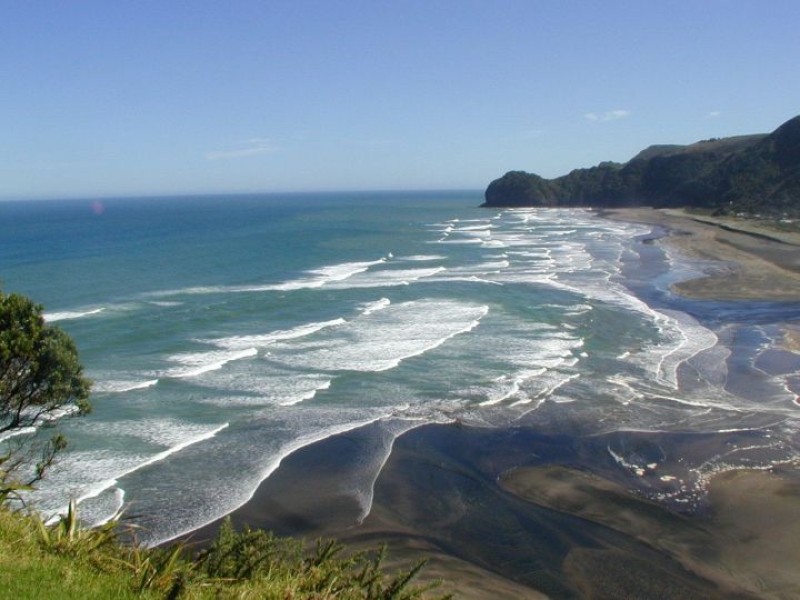Potentially lethal to swimmers, while providing a handy tow for experienced surfers, rips are a hazard on most of New Zealand’s favourite swimming and surfing beaches.
Potentially lethal to swimmers, while providing a handy tow for experienced surfers, rips are a hazard on most of New Zealand’s favourite swimming and surfing beaches.
So what, exactly, is a rip?
A rip is a strong current concentrated in a narrow deep channel running offshore or at an angle to the beach. It’s like a jet of water that flows at speeds of up to two metres per second (faster than your average swimmer can handle) and tows swimmers out to sea. “The majority of beach-based rescues are the result of rips,” says Surf Life Saving New Zealand’s Nathan Hight.
Rips are formed by a combination of big waves and the shape and position of sandbars, which influence how the tide interacts with the waves. Research by NIWA and others has shown that the type of rip you get depends on the wave type, tide range, and slope of the beach.
“Rips start pumping about falling half tide because the water brought in by the tide has to escape through rip channels,” says Dr Terry Hume, a coastal scientist at the National Institute for Water & Atmospheric Research (NIWA). “As a rule, the larger the incoming waves, the more likely the development of rips. Rips don’t form when there’s no surf (breaking waves), although the channels may still be there.”
“The danger of surf depends on the size and period [time between crests] of the waves,” Dr Hume explains. Short waves that come close together [e.g. every two seconds] don’t have much power. Whereas if they come from a long way and are further apart [e.g. every 10 seconds], they’re more powerful.”
Rips usually occur in regular sequences down the beach and will stay in the same position in moderate surf. As waves get bigger, the number of rips may reduce, but those remaining grow stronger. “The position of rip channels can also change in the course of a day with a really big storm,” says Dr Hume.
NIWA monitors a number of New Zealand beaches using time-lapse photography (the ‘Cam-Era’ video monitoring network familiar to surfers and homesick Kiwis). The cameras record how beaches change under different wave conditions, and enable us to better predict rips.
Open stretches of beach on New Zealand’s west coast tend to be more exposed to storms, and so the rip currents shift about more than on beaches enclosed by headlands, such as those on the Coromandel Peninsula and the Otago coast.
As for the hazards they pose, rip currents carry water and sand offshore, can cause localised shoreline erosion, and develop deep channels in the seabed. Poor swimmers can suddenly lose their footing in deep rip channels and be carried out to sea by the strong currents. To stay safe, swimmers should look for signs warning of rips and swim between the flags where Surf Life Saving New Zealand patrols the beach (see the accompanying table for further advice).
Scientist bio:
Dr Terry Hume is a marine geologist and coastal oceanographer at NIWA’s Hamilton office, where he is also Assistant Regional Manager. His research interests focus on large-scale coastal processes, including the natural transport and storage of sand, coastal hazards and beach erosion, and developing and applying beach and estuary classifications for research and management purposes. He holds an Honorary Associate Professorship at the University of Auckland and an Honorary Lectureship at the University of Waikato. He’s also a keen surfer.
Links:
· Download an information poster about rip currents
· For wave conditions at seven New Zealand beaches, check out Cam-Era
· See beach hazard ratings at Coastal Explorer - select the ‘Beach’ tab, select ‘All Beach types’, click on the ‘Refresh map’ button, and click on a location on the interactive map.
|
Rips Fact File |
|
|
What is a rip? |
A strong offshore current that develops between shallow sandbars. |
|
How do you spot a rip? |
Offshore rips can be difficult to spot from the beach. Surf Life Saving New Zealand advises to look out for: · Calm patches (blue water) in surf with waves breaking (white water) each side · Rippled or criss-crossed water · Discoloured water (either darker because it is deeper or dirty because of the sand being churned by the current) · Foamy water · Adjacent sand bars |
|
How fast do they travel? |
Up to two metres per second (7.2 kilometres per hour) or more. |
|
How far do they travel? |
Rips only travel to the end of the rip channel. The length of rip channels varies greatly in New Zealand, from tens of metres on sheltered east coast beaches (e.g., Whangamata, New Brighton) to hundreds of metres in large surf on exposed west coast beaches (e.g., Piha, and Hokitika). |
|
When do rips occur? |
Only when the surf’s up! This is why rips occur more often and are stronger on west coast beaches. |
|
Things you should know: |
Don’t try to swim against a rip current. The advice from Surf Life Saving New Zealand is to ride the current out from the beach until it weakens, then swim parallel to the shore for 30–40 metres before returning to shore, swimming slowly. For further information, see: http://www.slsnz.org.nz/Resource.aspx?ID=10390 |
|
Something strange: |
Experienced surfers use rips like ski tows to get out to the surf, and surf lifeguards use them to reach victims quickly. |

